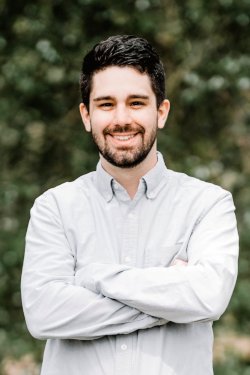James Daniel Brandenburg
2022 Regional Award Finalist — Post-Doc

Current Position:
Goldhaber Distinguished Fellow
Institution:
Brookhaven National Laboratory
Discipline:
Nuclear & Plasma Physics

Current Position:
Goldhaber Distinguished Fellow
Institution:
Brookhaven National Laboratory
Discipline:
Nuclear & Plasma Physics
Recognized for: Remarkable experimental achievements at the frontier of high-energy nuclear physics that are changing our understanding of the properties of light and matter. At Brookhaven National Laboratory, Daniel Brandenburg, PhD, uses the Relativistic Heavy-Ion Collider (RHIC) to investigate the properties of subatomic particles, like quarks and gluons, which are the essential building blocks of visible matter (i.e., protons and neutrons). His work led to the very first experimental observation of the famous Breit-Wheeler process—the simplest physical process by which photons of light are converted into matter. Brandenburg is also credited with a number of other remarkable discoveries in experimental high-energy physics.
Areas of Research Interest and Expertise: Quantum Electrodynamics, Nuclear Physics, Quantum Entanglement (Particle Physics), High Energy Physics
Previous Positions:
BS, University of Florida (Advisor: Ivan Furic)
MS, Rice University (Advisor: Frank Geurts)
PhD, Rice University (Advisor: Frank Geurts)
Postdoctoral Research Associate, Brookhaven National Laboratory, Center for Frontiers in Nuclear Science, Stonybrook University, Shandong University
Future Position: Assistant Professor, The Ohio State University (starts January 2023)
Research Summary:
James Daniel Brandenburg, PhD, is a physicist working at the frontier of high-energy and nuclear physics. At Brookhaven National Laboratory, Brandenburg uses the Relativistic Heavy-Ion Collider (RHIC) to investigate the properties of subatomic particles, like quarks and gluons. Quarks and gluons are some of the most essential building blocks of protons and neutrons—the visible matter found at the heart of an atom’s nucleus. By colliding ions of gold at velocities near the speed of light, RHIC became the first machine capable of creating a phase of matter called the quark-gluon plasma—a near-perfect liquid soup of quarks and gluons. These collisions yield important clues about the nature of visible matter.
Brandenburg and his colleagues were the first to recognize the importance of a particular kind of collisions at RHIC—known as ultra-peripheral collisions—where the gold ions don’t actually collide, but the photons of light around them do. His work on this topic upended the scientific community’s long-held understanding of the properties of light (photons) produced during these high-energy collisions, and remarkably, led to the first experimental observation of the famous Breit-Wheeler process—a process first predicted in 1934 from Einstein’s energy mass equivalence, E=mc2. The Breit-Wheeler process is the simplest process for converting light energy (photons) into matter. In collaboration with theorists, Brandenburg has made a number of other remarkable experimental discoveries, including the first experimental observations of a novel form of quantum interference that results from quantum entanglement and vacuum birefringence, which is an obscure optical property of light that only occurs in presence of extreme environments (very strong magnetic fields), altering the speed of light. His novel scientific insights are helping scientists unravel the mysteries of visible matter in our universe and helping set the stage for the next generation of nuclear physics experiment in the United States.
Physicists have tried to convert light into matter for almost a century - to achieve the concept immortalized in Einstein's famous equation, E=mc2. I found an unlikely approach with near misses in an atom smasher to finally make it possible.
Key Publications:
Other Honors:
| 2020 | Goldhaber Distinguished Fellowship, Brookhaven National Laboratory |
| 2019 | Nuclear Physics A Young Scientist Award, Quark Matter |
| 2019 | RHIC & AGS Thesis Award runner-up, RHIC & AGS Users Meeting |
| 2016 | Chuoke Award, Rice University |
| 2014 | Sam & Helen Worden Fellowship |
| 2013 | Sam & Helen Worden Fellowship |
| 2009 | Naval Office of Advanced Research Fellowship |
| 2009 | Congressional Medal of Merit, U.S. Congressman Bill Posey |
In the Media:
Inverse – Scientists managed to take pure energy and create matter—and new physics
Vice – Government Scientists Are Creating Matter From Pure Light
ScienceNews – Colliding photons were spotted making matter. But are the photons ‘real’?
Brookhaven National Laboratory – Collisions of Light Produce Matter/Antimatter from Pure Energy